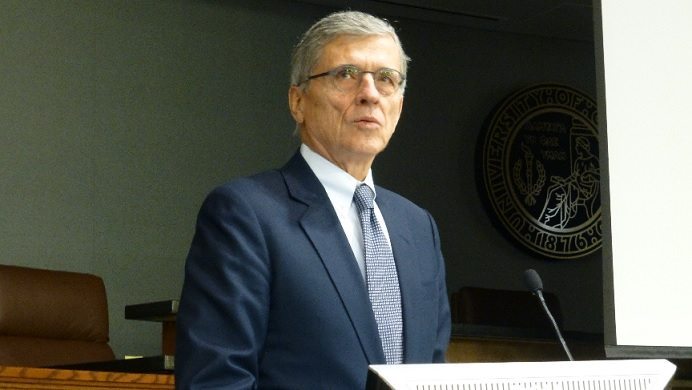With the Federal Communications Commission’s plans for its highly anticipated incentive auction process set to begin mid-2015, FCC Chairman Tom Wheeler spoke at a Washington, D.C., think tank event to provide an update on the process as well as plans to free up spectrum in the 3.5 GHz band through a sharing agreement.
Speaking at this week’s Brookings Institution event, Wheeler laid out a number of challenges the commission is having to tackle in order to host the incentive auction proceedings. One of the most pressing is wrangling up enough spectrum in order to make the auction process a success in getting sufficient spectrum into the hands of carriers.
Wheeler told the audience that it would be appropriate to manage expectations at this point, noting that of the six spectrum auctions conducted with airwaves below 3 GHz, the amount of spectrum up for grabs has in all cased been below 90 megahertz, with an average of 45 megahertz available for bid. This would seem to indicate that the FCC is not expecting a significant amount of spectrum to be freed up for the process, thus likely limiting the size of licenses and total amount of licenses up for bid, both of which could drive up individual license prices.
In attempting to garner support from broadcasters, Wheeler said the FCC is working to convince those licenses holders to hand over their spectrum in exchange for financial compensation as well as to tap into technological advances that have been made that will allow them to continue their operations unimpeded.
“The auction presents a once-in-a-lifetime opportunity for broadcasters, and we are committed to providing them with information about both our process and the financial opportunity the auction represents to enable them to make informed business decisions about whether and how to participate,” Wheeler said.
Analysts noted in a newly released RCR Wireless News report that convincing broadcasters to hand over such a valuable commodity will indeed be the most challenging aspect for the FCC in pulling off the incentive auction proceedings. Despite the challenges, Wheeler remains optimistic that the proceedings will prove successful for broadcasters.
“Seldom have I seen such a risk-free opportunity as that represented to broadcasters by the incentive auction, including the opportunity to continue their existing business on shared spectrum and take home a check for the spectrum they vacate,” Wheeler said.
Wheeler also noted that unlicensed use will be served by the auction process, with guard bands expected to be used for that purpose. The total amount of unlicensed spectrum to come out of the auction will hinge on “engineering and mathematics: the number and extent of the guard bands is a reflection of what is (in the words of the statute) ‘technically reasonable to prevent harmful interference between licensed services’ that will operate on the auctioned spectrum.”
In addition to the incentive auction proceedings, Wheeler updated the audience on plans to open up the 3.5 GHz spectrum band for shared use between government and the wireless industry, entitling the band the “innovation band.” Wheeler noted that he planned to circulate a proposal to FCC commissioners tapping into the 2012 President’s Council of Advisors on Science and Technology report regarding different tiers of sharing in the 3.5 GHz band, a “single, highly flexible band plan” and plans for a range of uses, including small cells.
“The 3.5 GHz band provides a real-life opportunity to apply some bold thinking about receiver performance. In parallel to our formal rulemaking, I expect that a multi-stakeholder group will be convened to explore ways to drive not only efficient transmission, but also efficient reception, in the band,” Wheeler explained.
The 3.5 GHz band is now in the hands of the Department of Defense for use in certain radar installations, as well as by “non-federal fixed satellite service earth stations for receive-only, space-to-earth operations and feeder links.” The somewhat limited propagation characteristics of the 3.5 GHz band are thought to be a good fit for the dense deployment plans for small cells and would likely limit interference with current users.
“To seize those new opportunities – for job creation, health care, education, energy – entrepreneurs will have to update the way they do business, and the FCC has to update the way we manage and allocate spectrum,” Wheeler noted in his closing comments.
Bored? Why not follow me on Twitter?


